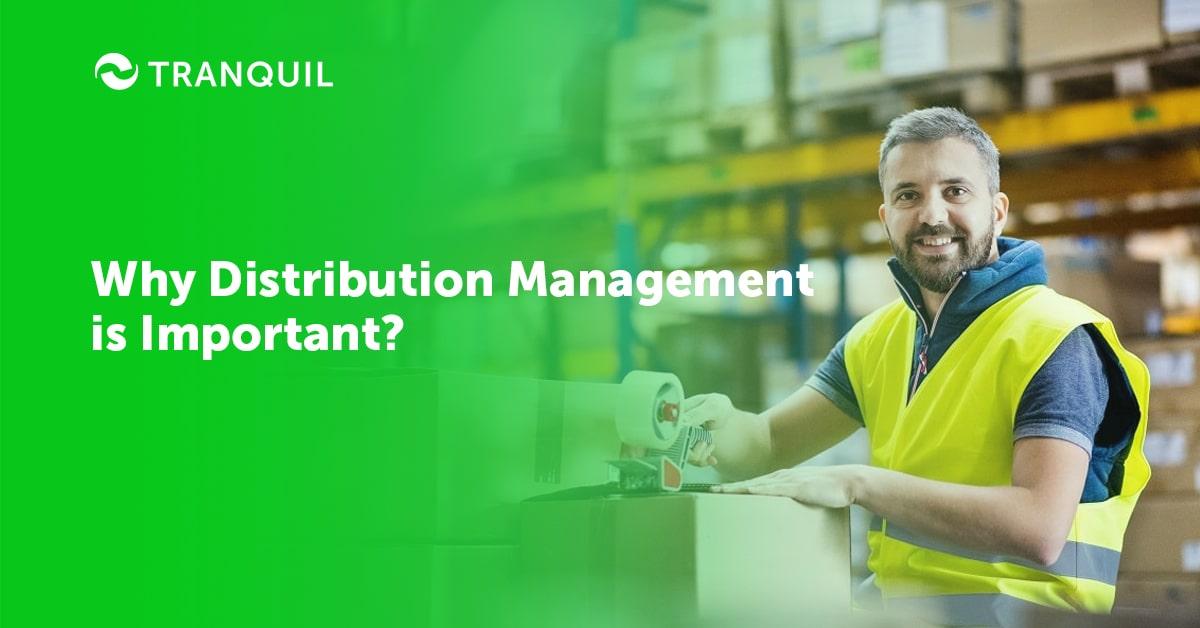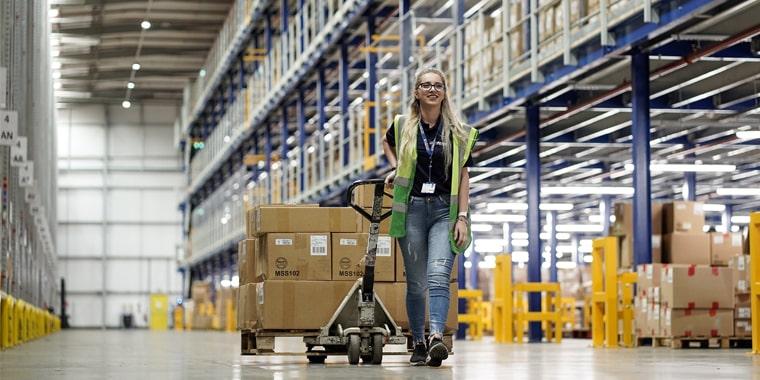
Distribution management is a business challenge that needs to be effectively tackled to ensure proper growth.
Raw materials being delivered earlier than required and getting damaged, or finished products arriving too late to fulfil consumer demand – both are potentially disastrous for business.
To manage distribution successfully, you have to have a robust strategy backed by real-time data and efficiently handle the different elements involved.
ALSO READ: Important ERP Modules and Functions
Distribution management refers to the process of supervising the movement of raw materials or finished products from the vendor to the manufacturer, from there to the wholesaler, then to the retailer, and finally, to the end-user.
Several processes and activities like managing the raw materials supplier, warehousing, logistics, supply chain, packaging, inventory, etc.
It is a critical element of the business cycle, especially for wholesale dealers and distributors.
For any business, the speed at which they can turn their goods over determines their profitability.
The importance of distribution management can be understood from the fact that if implemented properly, it can help businesses stay competitive and deliver customer satisfaction.

The ability of a business to attract customers and be profitable depends significantly on how well they manage distribution.
To be successful in this activity, it is imperative that the whole distribution process is managed with precision.
This is especially true of larger corporations with numerous suppliers.
Effective management of distribution in such cases can only be achieved when they automate processes through the implementation of distribution management software.
ALSO READ: Guide on How Do ERP Systems Work
Distribution management today is not merely about moving your products from one point to another.
You need to collect and share important information that will help in the identification of growth opportunities in the market and help you stay competitive.
Tech-savvy companies use distribution forces to gather market intelligence which allows them to evaluate their competitiveness.
There are two types of distribution management: sales or commercial distribution, and logistics or physical distribution.
Numerous functions are involved in distribution, including but not limited to – inventory management, customer service, warehouse planning, receiving, handling, and managing materials, information sharing, and more.
The goal of distribution management is to attain the most efficient delivery of raw materials, finished products, and work-in-progress (partially finished goods) to the correct place and in time, in the right condition.
The planning of physical distribution must be aligned with the overarching channel strategy.
ALSO READ: Understanding Different ERP Systems
An individual or business that engages in the supply of products in bulk to retailers or other businesses who sell to the end-usersare called distributors.
Let’s see a few examples:
A connected group of transportation systems and storage services is referred to as a distribution system.
It is developed in line with a distribution strategy created to ensure the movement of goods from a manufacturer through various agents, till it reaches the ultimate buyer.
ALSO READ: Benefits of Mobile ERP

While both distribution and logistics deal with efficient movement and delivery of goods, there is a major difference.
Distribution management is only a part of the larger logistics management activity.
Logistics deals with the precise planning and various activities that aim to supply and transport goods effectively.
Bulk shipping and management, supply management, fleet management, delivery routing, security, temperature controls, warehouse, tracking shipments, etc. are the various activities involved in logistics or physical distribution.
On the other hand, distribution management is a system within logistics that is focused on fulfilling orders through distribution channels.
The channels mean the agents and other entities that a product goes through from its point of origin till it reaches the end-user.
Independent or third-party distributors, retailers, wholesalers, and e-commerce sites are some examples of distribution channels.
Commercial or consumer packaging, fulfilling orders, and shipping them are processes involved in distribution.
The importance of distribution in supply chain management is due to the fact that it deals with getting goods to the end-user or buyer in time, and with minimal waste.
This means that it directly impacts your profits.
ALSO READ: Benefits Of ERP Software For Logistics Industry
This is simply referring to the steps involved in sending the product from the manufacturer through various entities to the eventual consumer.
Typically, this includes:

We have read in the previous paragraphs that distribution management offers numerous benefits to businesses when effectively implemented.
These include waste reduction, lower costs, and increased customer satisfaction.
Let us examine the benefits in detail:
When you implement a sophisticated management system, you make it simple and convenient for your customers to shop.
Without an efficient system, customers would not get most of what they wanted in a single store, and would have to go to multiple stores – and this would be very bothersome indeed.
ALSO READ: Must-Have HRMS Modules and Features
Without a proper supply chain and distribution management system, retail stores may get products in bulk directly from the manufacturers, and it will be almost impossible for them to store that much quantity.
By streamlining all your processes, you stand to save a great deal of money as you won’t have to shell out extra money for urgent deliveries.
With a proper system in place, you will have whatever you need in time.
With a robust distribution management system in place, you can significantly reduce delivery errors.
You will also be able to get more clarity on the products that have to be delivered.
With a proper distribution management system, the chain of supply is much smoother.
ALSO READ: Benefits Of Software As A Service
When you have an advanced distribution management system, you can order exactly how much quantity of an item you need for a specific period.
This helps to ensure that you don’t miss any sales opportunities and are able to offer your customers their favorite products.
Monitoring and managing your inventory becomes a breeze with the right distribution management system as everything is properly accounted for.
Every inventory item that is delivered and shipped out is accounted for, giving you an exact inventory count.
ALSO READ: What is Inventory Cycle Counting?
There can be multiple disruptions in distribution management, caused by various factors.

You must consider the purchase habits of customers as the rises and dips in sales influence distribution patterns.
Tracking them can help you plan appropriately.
Time is crucial when you are dealing with perishable products like medicines and food products.
Even the slightest delay in timing can cause your stock to get damaged and unsellable, leading to financial loss.
ALSO READ: Demand Forecasting and Its Importance
A manufacturer’s or retailer’s demand is subject to change and can impact your distribution.
You must make the most of every delivery; this means ensuring that your trucks are loaded to their maximum capacity and that they are on the most efficient routes for delivery.
Certain products sell better at specific times of the year; for example, air-conditioners are likely to sell more before summer sets in.
You need to consider what product mix will be optimal.
ALSO READ: What is Zero Inventory and Why it is Important?
There are three main strategies of distribution management:

Most goods are shipped by manufacturers to wholesalers; as we read previously, pharmaceutical companies distribute medicines to pharma wholesalers.
Products are sent from the wholesaler, and sometimes the manufacturers, to the retailers.
For example, clothes are distributed to clothing chains and departmental stores.
This entity transports products from the manufacturer to an authorized distributor.
Let’s take the example of a Toyota factory that distributes Toyota cars of different models to authorized Toyota dealerships.
ALSO READ: What Is Cloud Data Protection?
This is the latest distribution channel, where products and services are displayed online in virtual stores, and shipped (distributed) directly to the buyer.
The emergence of this channel has brought in sea changes, leading distributors to innovate and shift from conventional strategies and methods.
Let us quickly recap the importance of distribution management:
ALSO READ: Why is Cycle Stock Important for Your Business?
It is vital that you select the appropriate distribution management system for your organization.
Of course, this depends to a great extent on the goals and challenges of your company, and the channels and models of distribution it uses.
However, there are a few common factors to bear in mind:
Tranquil ERP is a robust system that ticks all the above boxes. Do schedule a demo with us, and we will show you how it can benefit your business. We are happy to answer all your queries.